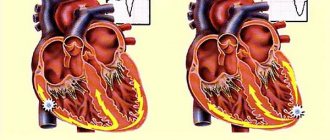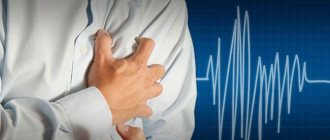Changes in heart function in old age
The heart is often called the engine in the human body. After all, this organ, only the size of a fist, is responsible for the life support of the entire body. Through the heart, blood enters every cell of the body, and with it the necessary nutrients.
Old age is characterized by changes and disturbances in the functioning of the heart muscle.
- The size of the heart increases. A common occurrence in old age is an increase in the size of the left ventricle of the heart, the walls of which thicken and begin to conduct less and less blood into the chamber. It fills up very slowly compared to previous years. Therefore, when comparing the size of the heart and its efficiency in elderly people, one can note negative dynamics compared to younger people.
- The contractility of the heart muscle decreases. By the time a person reaches 70 years of age, their heart pumps about 165 million liters of blood. When thinking about how to strengthen the heart in old age, it is worth knowing that its performance directly depends on the condition of myocardial cells, which become fewer and fewer over the years. The reason for this is the impossibility of self-renewal of cardiomycytes, in the place of which connective tissue is formed. The body tries to replace dead cells with it in order to strengthen the surviving ones. However, full compensation for the work of dead cardiomycytes cannot be achieved in this way.
- The functioning of the heart valve apparatus is disrupted. The mitral and aortic valves are the most susceptible to age-related changes, the valves of which lose their flexibility over time. Loss of elasticity, among other things, can be caused by the accumulation of calcium in the heart. As a result, heart failure occurs due to the functionality of the valve, which leads to uneven distribution of blood throughout the cavities of the heart.
- Heart rate changes. Impulses for pumping blood by the heart are generated by cells that die during the entire time a person lives in the world. In elderly people, the number of functional cells rarely exceeds 10% of the initial level, which certainly leads to arrhythmia.
We recommend
“Features of older people: psychological and physiological” Read more
Propranolol (Anaprilin, Obzidan, Inderal...)
It has been established that such a popular medicine as Propranolol
can sharply worsen the patient’s condition when taken even in a therapeutic dose
.
This usually happens if the doctor focuses only on arrhythmia and other individual symptoms and does not treat the underlying disease. The result of this error is cardiac arrest and, as a consequence, death. Propranolol
is an international generic name; this substance is better known in our country under the trade names
Anaprilin, Obzidan, Inderal.
Propranol is produced
by different manufacturers and under other trade names.
Trade names of drugs with the active ingredient Propranolol: Anaprilin
1.2273 Anaprilin injection solution 0.25% 0.0496 Anaprilin tablets 0.0693 Vero-Anaprilin 0.0106
Inderal
0.0526 Inderal LA 0.0066
Obzidan®
0.1709 Propranobene 0.0035 Propranolol 0.134 Propranolol Nycomed 0.0 137 Propranolol hydrochloride 0.0197
Below we present packaging from only the most popular manufacturers.
How to strengthen your heart in old age with moderate exercise
Unfortunately, sick people often know more about the benefits of health. But it is always better to prevent heart problems by consciously working on strengthening your striated muscles. The best means for this will be physical exercises, which are performed taking into account certain rules.
- You should train regularly, keeping equal intervals between classes. It is better if they take place at least 2 times a week.
- The workout should last 60 minutes and include a variety of activities and intensity levels.
- It is better to do physical exercise in the fresh air. If this is not possible, there should be natural ventilation in the room where classes are held. Exercise should stimulate ventilation of the lungs. Such measures will provide the necessary aerobic load for the entire body, which allows lactic acid to be completely oxidized in the tissues, which reduces the contractility of muscles, including the heart.
- When thinking about how to strengthen the heart in old age, in addition to physical education, which has a positive effect, you should also get rid of the negative effects: smoking, lack of sleep, aggression and stress.
We recommend
“Vitamins for elderly people over 70: which ones are needed first” Read more
(synonyms: Motilium, Motilak, Motinorm, Domet, Motonium, Omez D)
Gastroenterological drug Domperidon, which is prescribed to treat heartburn.
The US Federal Drug Administration has warned health care workers and breastfeeding women about the dangers of using domperidone (Motilium).
to stimulate lactation.
Despite the fact that domperidone is usually used for gastric dysfunction, in some cases it is prescribed to enhance lactation. The use of domperidone is considered to be risky for the child. In addition, intravenous use of domperidone has been documented to be associated with cases of arrhythmias, heart attacks, and even cases of sudden death have been reported.
Information source: medscape.com/viewarticle/480711?src=mp Domperidone Causes Serious Health Risks in Lactating Women
What foods help strengthen the heart in old age?
- Legumes contain calcium and soluble fiber, which activate digestion and heart function.
- Lean meat (beef, chicken, turkey, rabbit).
- Fish, which, unlike meat, should be fatty: mackerel, herring, salmon and other red varieties. If you can’t buy fish often, you should supplement your diet with fish oil tablets.
- Olive oil. Helps keep cholesterol levels within normal limits.
- Oatmeal. In addition to useful vitamins and microelements, this porridge has a calming effect on the heart.
- Cottage cheese and fermented milk products, which are also rich in calcium.
- Multigrain bread. It is better to prefer rye or whole grain varieties to yeast bread made from white flour.
- Vegetables and fruits, the daily intake of which should be from 400 grams. The emphasis should be on foods rich in potassium: jacket potatoes, raisins, dried apricots, dates, banana, parsley and other greens. It is important to note that raisins are healthier than fresh grapes because, in addition to containing glucose, which is important for the heart, they do not have sugar.
- Nuts. For heart health, you should definitely eat a handful of any nuts every day: walnuts, pine nuts, hazelnuts, cashews, etc.
We recommend
“First aid for the elderly: what you need to know about it” Read more
Diet for the prevention of cardiovascular diseases
Let's now talk about what kind of diet is recommended for the prevention of cardiovascular diseases. Today, there is a large amount of research on the topic that the Mediterranean diet is the most effective in preventing cardiovascular diseases.
Study
: The Mediterranean Diet: its definition and evaluation of a priori dietary indexes in primary cardiovascular prevention, Mediterranean diet and reduction in the risk of a first acute myocardial infarction: an operational dietary healthy score
The classic Mediterranean diet involves eating plenty of extra virgin olive oil, fruits, nuts, vegetables, whole grains, moderate amounts of seafood and poultry, and limiting fatty dairy products, red meat, processed meats and sweets. .
Why does this type of diet significantly reduce the risk of developing CVD? Let's figure it out.
Vegetable oils and fatty sea fish are rich in omega 3 fatty acids, which are essential components of cardiovascular health, reducing high cholesterol and increasing HDL.
Pectin, found in some fruits and berries, has also been shown to lower LDL levels and increase HDL by reducing the absorption of cholesterol in the intestines and increasing the excretion of bile acids. The largest amount of pectin is found in black currants, beets, apples, plums, oranges, carrots, and cabbage.
Also, berries, fruits and colored vegetables are rich in bioflavonoids, which are known not only as powerful antioxidants, but also as substances that inhibit the oxidation of LDL, reducing the risk of developing atherosclerosis. Flavonoids such as quercetin and rutin suppress lipid peroxidation in mitochondria. In addition, the “French paradox” is known - a low incidence of CVD when drinking red wine containing quercetin, rutin, resveratrol, within reasonable limits, of course.
How to strengthen the heart in old age using folk remedies
Strengthening tea made from hawthorn, rosehip and sea buckthorn
Even mono-drinks made from hawthorn or pure rosehip alone can strengthen the heart muscle.
And if you brew tea from three ingredients at once, you can simultaneously nourish, tone and cleanse your blood vessels.
For a general strengthening drink, you will need dried fruits, taken in equal proportions. It is ideal if the fruits are harvested independently. But a pharmacy or market option is also suitable.
If sea buckthorn is purchased fresh or frozen, you need to squeeze the juice out of it before brewing.
For brewing, you can prepare in advance a mixture of fruits taken in equal quantities and place them for storage in a linen bag or glass jar. The components can also be stored separately, taking approximately 1.5 tsp. each of them immediately before brewing. When using the prepared mixture, you need to brew 2 tbsp. l. for 250 ml of boiling water.
After the fruits are filled with water, they need to be infused for 20 minutes and strained. You can sweeten the drink with a teaspoon of honey. The decoction should be consumed 2 times a day.
Vitamin mixture MILOC
One of the most famous general strengthening and immunomodulatory folk remedies is named after the first letters of its components: honey, raisins, lemon, nuts and dried apricots. This mixture is rich in potassium and vitamin C, which the heart needs so much. Having prepared such a remedy, you don’t have to wonder how to strengthen the heart in old age for a long time.
To prepare the mixture, you need to take 200 g of each of the listed ingredients. Bulk components can be weighed upon purchase. One large lemon weighs just about 200 g. And you will need about 3/4 cup of honey.
The type of nuts does not matter much. The ideal option would be walnuts.
At the beginning of cooking, raisins and dried apricots are poured with warm water and set aside. After the dried fruits have softened, they need to be dried on a paper towel.
Lemon is cut in half and into slices. Be sure to remove all the seeds.
All solid components should be minced through a meat grinder, honey should be added to the resulting puree and stirred thoroughly. The finished mixture is placed in a jar with a lid.
To prevent diseases and strengthen the heart, take 1-2 teaspoons of the product three times a day, half an hour before meals. The mixture can be washed down with tea.
Additionally, you can add prunes, pumpkin seeds and a spoonful of cocoa. It turns out to be a very tasty and healthy delicacy.
Viburnum with sugar or honey
Viburnum berries contain a whole range of different vitamins, which makes them popular for treating colds and other diseases.
The most valuable component in viburnum is the glycoside viburnin, which gives the berries a peculiar bitter taste. It is this element that is necessary to support the heart muscle.
The bitter taste, of course, is compensated by the beneficial properties of viburnum, but to reduce its manifestation, the berries can be poured with boiling water before consumption. Another way is to mix viburnum with honey, which will preserve all the beneficial qualities of the berry, but at the same time reduce the bitterness. In addition, this mixture is very convenient to store.
To prepare a healthy mixture, you need to wash and dry the berries, and then pass them through a meat grinder. Honey or sugar is added to the resulting slurry in equal proportions.
It is recommended to eat 1 tablespoon of this mixture several times a day.
Lemon-garlic mixture
This one is from the Bulgarian seer Vanga, who probably knew how to strengthen the heart in old age. The product helps to effectively clean blood vessels.
To prepare you will need 10 lemons, 10 heads of garlic and 1 liter of honey. The garlic needs to be peeled. The lemon is cut into slices, the seeds must be removed from the pulp. Then everything is scrolled in a meat grinder. Honey is added to the resulting puree. The finished mixture should be left for a week in a dark place, and then consumed 2 tablespoons in the morning.
We recommend
“How to choose a boarding house: we take into account all the criteria and pitfalls” Read more
Vitamins and minerals to strengthen your heart as you age
Vitamins enable older people to slow down the aging process of body cells, improve overall well-being and give them vigor.
For efficient functioning of the heart muscle, older people should consume the following vitamins:
- C (or ascorbic acid) accelerates metabolism, strengthens the myocardium and vascular walls, and perfectly resists the development of atherosclerosis;
- A (or retinol) dissolves cholesterol plaques;
- E (tocopherol) performs an antioxidant function, prevents aging, strengthens the heart and blood vessels, making them elastic;
- R (or rutin) has a strengthening effect on blood vessels, reducing permeability and bleeding;
- F (a complex of unsaturated fatty acids, including linoleic and linolenic) – is responsible for strengthening muscle tissue (including the heart), avoiding the formation of plaques in blood vessels;
- Q10 (coenzyme) – is also synthesized in the human liver, providing energy, reducing the risk of heart attack or arrhythmia;
- B1 (thiamine) ensures a rhythmic heartbeat;
- B6 (pyridoxine) – reduces the amount of lipids and cholesterol in the blood.
In modern pharmacies you can also find vitamin complexes specially designed for older people. Their regular use not only reduces the risk of heart disease, but also strengthens the entire body, including the immune system.
The following microelements will also help improve the condition of the cardiovascular system:
- Mg, helps the absorption of sodium and potassium in the blood, normalizes blood pressure, heals the myocardium and dissolves blood clots.
- Ca is an essential element for the contractility of the heart muscle.
- P is a building element of cells, which, being embedded in their membranes, transmits impulses throughout the myocardium, affecting heart contractions.
- Se – helps in the fight against free radicals that destroy blood vessels and heart tissue,
- Cr – prevents the occurrence of hypertension and heart disease.
participates in the body’s absorption of other vitamins and microelements.
Of course, the aging body and heart need nutrients and vitamins. But it is important to consider that over the years, a person’s need for these elements decreases. In addition, recent studies have shown that in the body of older people, many minerals (such as calcium) are not absorbed, accumulating on the walls of blood vessels, in joints and cartilage.
Causes of cardiovascular diseases
The role of the cardiovascular system in the body is key. The cardiovascular system is a system of organs that circulates blood in the human body.
It performs many functions in our body, namely
:
- Transport
- the most important function, since oxygen and all nutrients are delivered to our organs and tissues with the help of the cardiovascular system, and carbon dioxide and all decay products are removed from organs and tissues also not without its help.
- Regulatory
- the ability to regulate the functions of organs and tissues by delivering mediators, biologically active substances and hormones to them, as well as, if necessary, changing their blood supply.
- Protective
- this is blood clotting during any injury to protect us from blood loss, as well as the participation of the cardiovascular system in immune and inflammatory processes in the body.
From its functions it is obvious that the cardiovascular system is the most important for us and our body, but why should we pay such close attention to it? Let's look at the statistics.
Today, cardiovascular diseases occupy a leading position in the causes of early mortality in the world, accounting for one out of every three deaths. Just think about these numbers!
Coronary heart disease accounts for the majority of CVD deaths, followed by stroke and heart failure. Most of these diseases are asymptomatic and we cannot even assume that we have any of the CVD diseases.
Let's list some of the cardiovascular diseases. These include
:
- Atrial fibrillation.
- Congestive heart failure.
- Coronary heart disease – atherosclerosis.
- Hypertension.
- Stroke.
- Myocardial infarction.
- Angina pectoris.
What can we do to minimize the risks of cardiovascular disease? First of all, let's look at the causes of these diseases. Conventionally, they can be divided into unchangeable and changeable risks.
Unchangeable risks include
:
- Age
— of course, preventive medicine is now developing by leaps and bounds, but unfortunately, it has not yet been possible to slow down the aging of blood vessels, even the use of statins does not always save the situation.
- Floor
— men have a greater risk of developing CVD.
- Ethnicity
. - Family history of cardiovascular disease
— if your relatives have a history of CVD, then you are automatically at risk.
And now let's turn to the risks that are subject to change. This is, of course, our way of life
:
- Nutrition.
- Alcohol.
- Smoking.
- Lack of exercise and sedentary lifestyle.
- Stress is both acute and chronic.
If the situation with alcohol and smoking is quite obvious - the less of the first and second in our lives, the better, of course. Let's take a closer look at the point about physical activity. Lack of physical activity is practically the number 1 reason for how our lipid profile and connective tissue change. Aging is activated by a sedentary lifestyle, because the body’s energy needs decrease, ATP production decreases, mitochondria die, and as we know, new ones are not formed, and then the entire body “crumbles.”
And of course, what also greatly influences the development of CVD is the type of diet we adhere to. Let's look at it in more detail.








